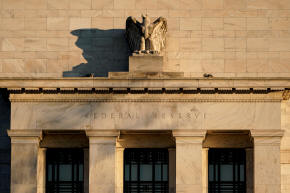Analysis-Some investors tiptoe back into Treasuries, as hawkish Fed
clouds outlook
 Send a link to a friend
Send a link to a friend
 [April 22, 2022] By
Davide Barbuscia [April 22, 2022] By
Davide Barbuscia
NEW YORK (Reuters) - Expectations that a
hawkish Federal Reserve will cause an economic slowdown are pushing some
investors to increase exposure to long-term Treasuries, as policymakers
continue signaling they are ready to ramp up their fight against
inflation.
Betting on upside in Treasuries has been a risky proposition this year.
Interest rates, which move inversely to Treasury prices, have galloped
higher in 2022 as the central bank has grown progressively more hawkish,
dealing the U.S. government bond market its worst start to the year in
history and gouging investors betting the selloff would abate.
Nascent Treasury bulls, however, believe that the meatier rate hikes and
speedy balance sheet tightening the central bank has signaled will
eventually slow U.S. growth expectations and prevent Treasury yields
from going much higher.
“We have been incrementally adding longer-duration bonds into our
portfolios in anticipation of market participants pricing in slower
growth moving forward,” said Gavin Stephens, director of portfolio
management at Goelzer Investment Management.

The Fed’s hawkish stance was underlined on Thursday when Fed Chairman
Jerome Powell said a half-point interest rate increase "will be on the
table" at the central bank’s monetary policy meeting next month.
Investors are pricing in over 240 basis points of tightening for the
rest of this year. [FEDWATCH]
Some economists have warned the Fed’s actions could make recession more
likely by potentially pressuring spending or precipitating drops in
stocks and other assets, hurting household wealth.
Stephens began adding longer-duration bonds weeks ago, after rates on
two-year Treasuries briefly exceeded those on 10-year Treasuries. The
phenomenon, known as an inverted yield curve, is viewed as a signal of
economic worries and has preceded past recessions.
Ten-year Treasury yields have historically moved lower after an
inversion of the 2s/10s yield curve, he said.
At the same time, net bets against U.S. Treasuries have recently hit
their lowest level since the end of 2021, a JPMorgan survey showed
earlier this month.
[to top of second column] |

The Federal Reserve building is seen in Washington, U.S., January
26, 2022. REUTERS/Joshua Roberts/File Photo

"The Fed's focus is fully on inflation ... (it) is prepared to inflict real
economic pain on the economy to achieve inflation goals," said Dean Smith, chief
strategist at investment firm FolioBeyond.
BofA Securities said earlier this week that yields on 10-year notes offered an
attractive entry point for buyers, expecting inflation to ease from recent
multi-decade highs.
"While CPI (consumer price index) inflation is 8.5%, we believe the market may
be overemphasizing inflation risks,” BofA strategists said in a note on
Wednesday.
Not surprisingly, plenty of investors are wary of betting on a reversal in
Treasuries after yields on the 10-year have climbed by 140 basis points this
year back to levels last seen in 2018.
Ryan O'Malley, a fixed income portfolio manager at Sage Advisory, recently
lightened his underweight position on Treasuries, due to expectations of lower
inflation and what he believes are early signs of slowing growth, such as recent
declines in home sales and homebuilder sentiment.
Still, he believes yields can rise further, especially as the central bank plans
to trim its nearly $9 trillion balance sheet at a projected maximum pace of $95
billion per month, an operation policymakers said they could initiate as soon as
next month.
"If the Fed starts to roll off nearly $100 billion a month and buyers don't show
up in large numbers to pick up the slack ... prices are going to go down and
yields higher," he said. "It's just the mechanics of the market."
(Reporting by Davide Barbuscia; Editing by Ira Iosebashvili and Cynthia Osterman)
[© 2022 Thomson Reuters. All rights
reserved.]This material may not be published,
broadcast, rewritten or redistributed.
Thompson Reuters is solely responsible for this content.
 |